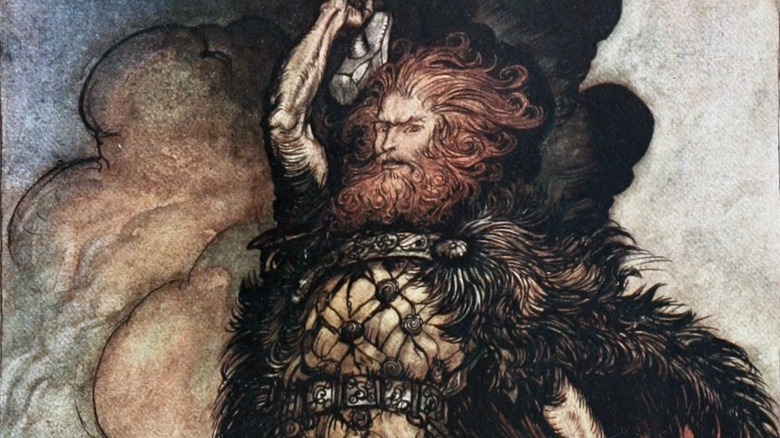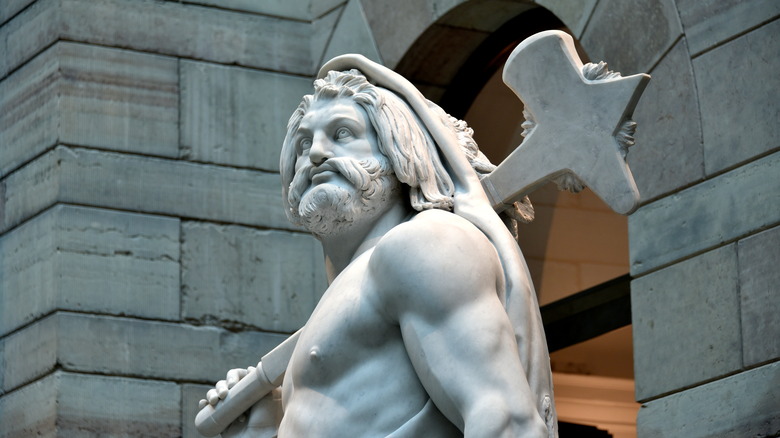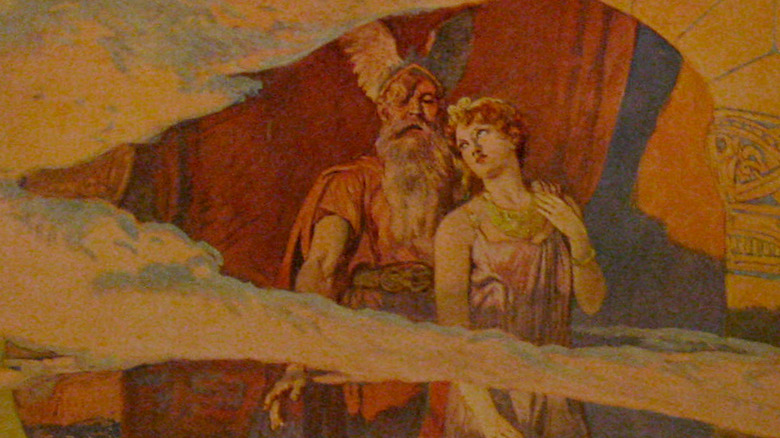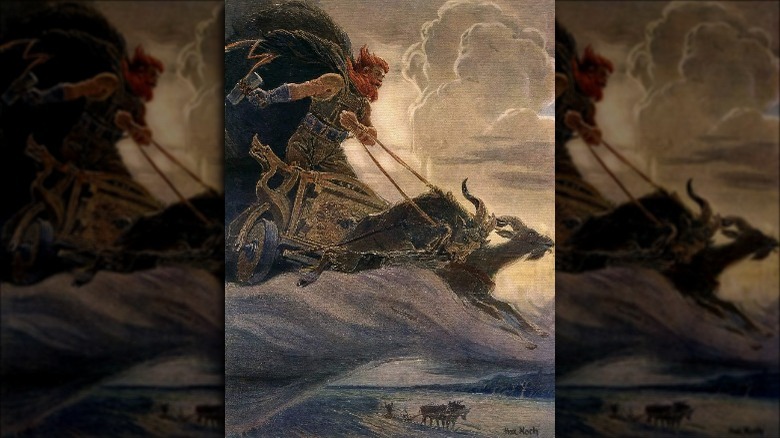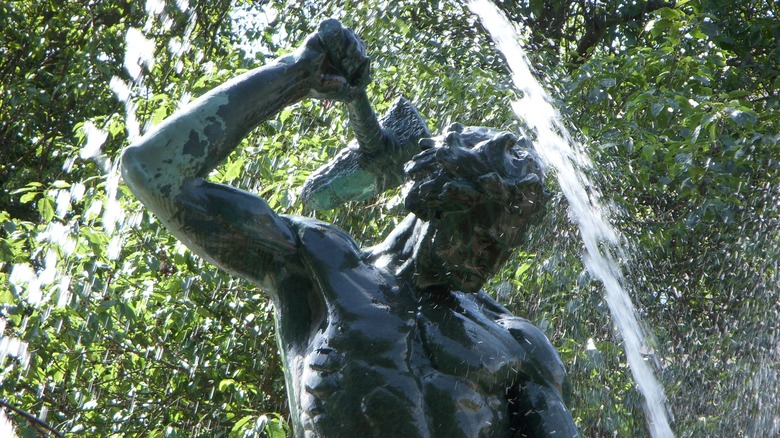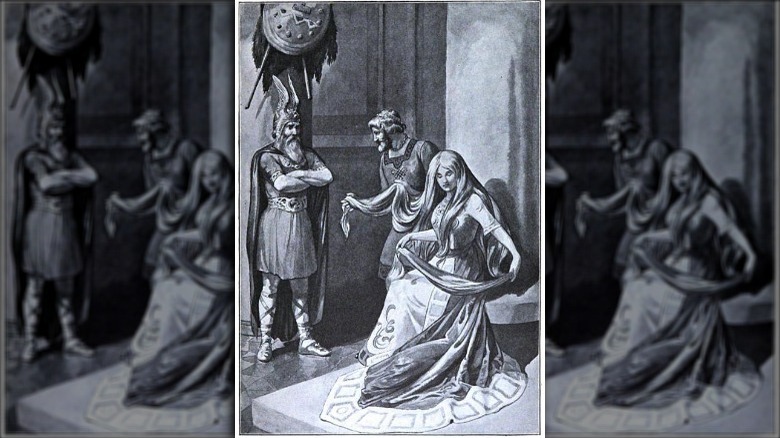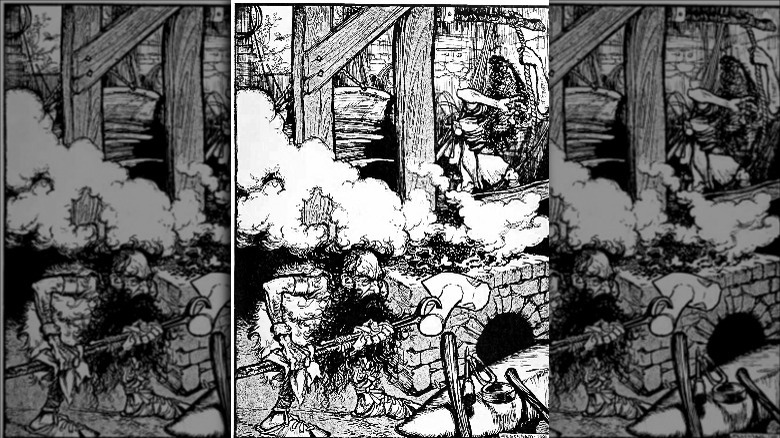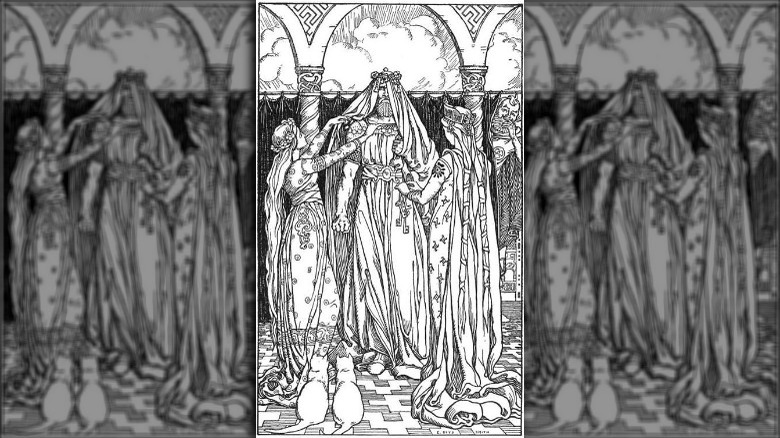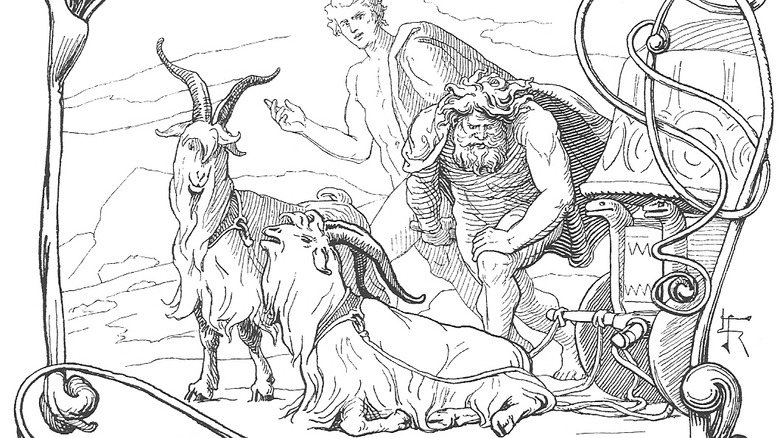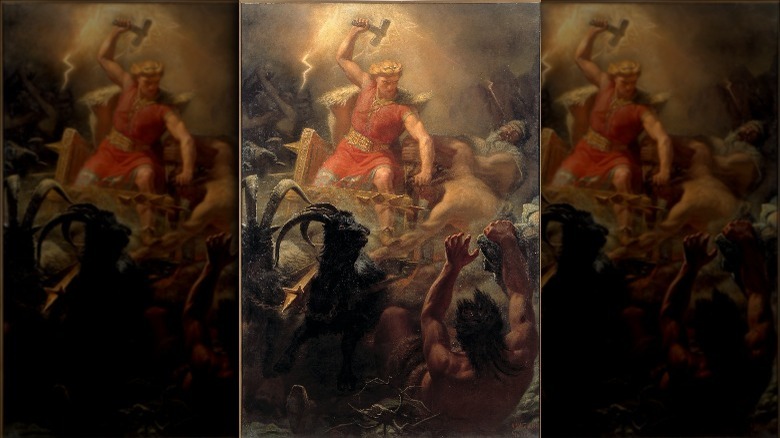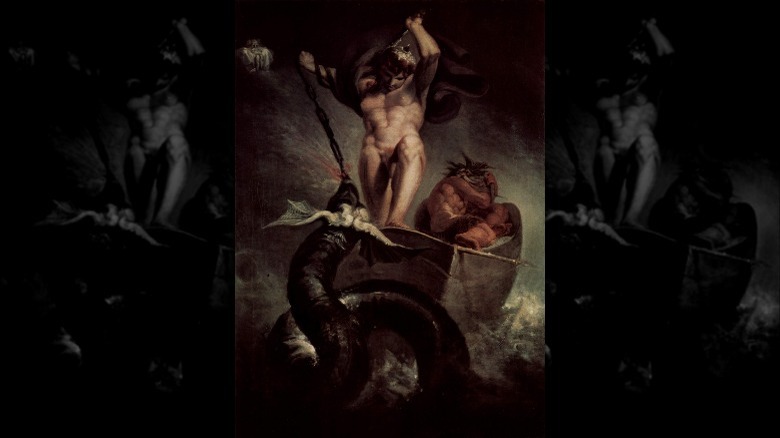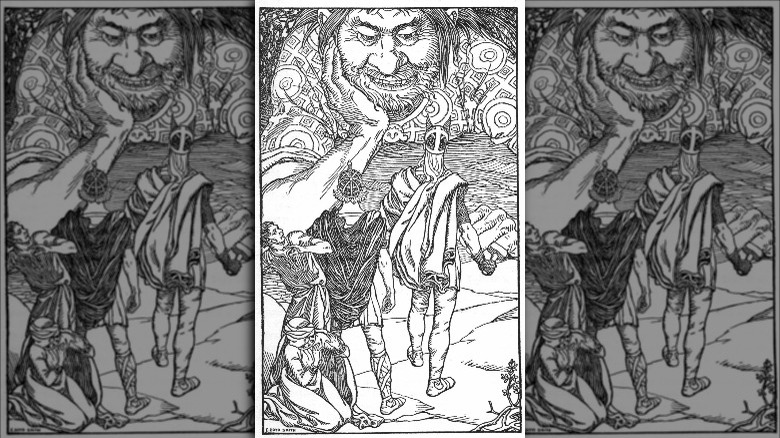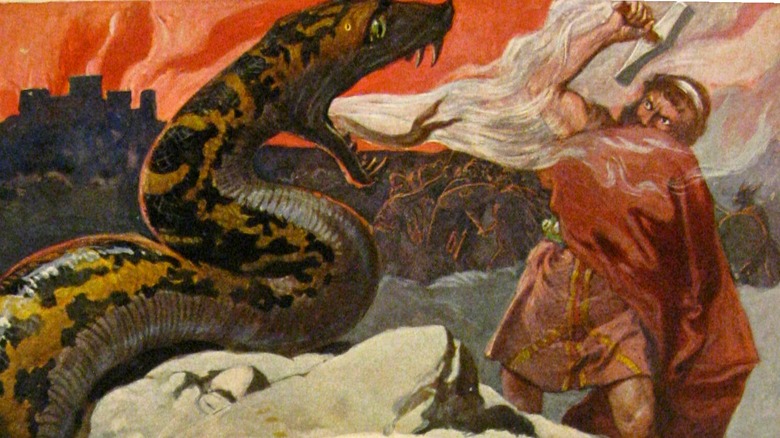The Mythology Of Thor Explained
The most famous of all the Norse gods arguably isn't Odin, their king, but rather his bold and boisterous son Thor, the god of thunder. Thanks to his role as the protector of humankind — the "warder of earth" as he is called in the mythological collection known as the "Poetic Edda" — and his Viking-like warrior spirit, Thor was one of the most beloved deities among the Germanic peoples of northern Europe. And thanks to adaptations of the thunder god's adventures by Marvel Comics and the related cinematic universe, a whole new millennium of fans can enjoy the exploits of Thor and his wonder-working hammer.
But if all you know about Thor comes from movies, you might be surprised at some things that were changed, left out, or that the filmmakers got wrong. Hop on to your flying goat chariot! This is the mythology of Thor explained.
Thor is more than just a name
Mythopedia explains that the name Thor derives from the Old Norse spelling Þórr, which is related to the Old Frisian thuner, the Old English thunor, and the Old High German donar, all of which were also names for Thor and derive from the Proto-Germanic Þunraz. You don't have to be a linguistics expert (though it helps to know that the letter Þ is a "th" sound) to figure out that all of these words, appropriately, mean thunder (the Old English thunor and Old High German donar are the sources of the Modern English "thunder" and Modern German "Donner," respectively). Thor is, of course, the personification of the natural phenomenon of thunder, so why not just call him Thunder, right?
When Roman culture spread out through Central Europe, the Romans identified the Germanic thunder god Donar with their own thunder god Jupiter, and so when the Germanic tribes adopted the Roman calendar, "Jupiter's day" ("dies Jovis," preserved as jeudi in French, jueves in Spanish, and giovedi in Italian) was translated as Þonares dagaz ("Thor's day") in Proto-Germanic, which became the Modern English Thursday and the Modern German Donnerstag.
Thor, a very popular god, had many other titles and epithets, including Atli ("the terrible,") Björn ("the bear"), Einriði ("the lone rider"), Harðhugaðr ("strong spirit"), and Vingthor ("the thunder-hurler"), among many other equally metal nicknames.
Thor's immediate family
Thor is one of the Aesir, the sky gods who inhabit the realm of Asgard. Mythopedia explains that he was the son of Odin, the chief of the Aesir and highest god of them all, known as the All-Father. Thor's mother, however, was not Odin's wife Frigg, but rather a giantess known variously as Jord (meaning "Earth"), Hlödyn, or Fjörgyn. Given Thor's penchant for turning giant bones into paste, it might be a little surprising to learn that he is technically half-giant himself. Because the heads of pantheons tend to be a little prolific in, well, sowing their wild oats, Thor has a number of half-brothers among the gods, including Balder (or Baldur), the god of beauty and light; Tyr, the god of war; and Heimdall, the guardian of the rainbow bridge that connects Asgard to Midgard, the world of humans.
One notable god that isn't Thor's brother is Loki, the trickster god of the Norse pantheon. While the Marvel version of Thor and Loki depicts them as adopted brothers with a love-hate relationship, the mythological Loki is the son of the frost giant Fárbauti and the goddess Laufey (the latter name is somewhat strangely used for Loki's father in the Marvel universe). If anything, Loki is more like an adopted brother of Odin, not Thor, though his relationship to everyone is pretty sketchy. It's fine, though. Thor has enough brothers without him.
What Thor looks like and what he does
Thanks to decades of comics and several billion-dollar-grossing movies, people generally have a picture in their head of a blond Thor, without a beard if they read the classic comics, or with a beard if they only know Chris Hemsworth's portrayal. However, as Mythopedia explains, the traditional version of Thor was thought to have red hair and a red beard. Other elements of Thor's character are a little closer in the movie version, like his prodigious appetite for food and women, and his insatiable thirst for mead. Additionally, Thor is bold, brave, mega-strong, and ultra-violent. He isn't known for his forward-thinking but rather leading with his fist (or hammer, as the case may be). When the gods need someone to demolish a troll, Thor is the one they call.
This blustery and violent character suitably reflects his role as the personification of a thunderstorm. Such storms were pictured by Germanic pagans as the sound and fury of the mighty thunder god careering around the sky in his goat-drawn chariot. Thor's association with rain and his voracious sexual appetite caused him to also be seen as a fertility and agricultural god in addition to being the quintessential warrior god. His bold warrior spirit and association with abundant crops helped make Thor one of the most popularly worshiped of all the Germanic gods, with his relics being among the most commonly found in northern Europe.
The legendary hammer of Thor
Thor's most famous weapon is, of course, his iconic hammer, Mjölnir. Norse Mythology for Smart People explains that Mjölnir was a short-handled hammer that when thrown would magically return to the thunder god's hand, an element that has been retained in the Marvel adaptation. The Germanic people imagined the peal of thunder as being the sound of Thor's hammer cracking skulls. Consequently, the streak of lightning across the sky was thought to be Mjölnir being thrown by the warring thunder god. In fact, while the origin of the name Mjölnir is unclear, most signs point to it deriving from a root that just means "lightning" (although there are some who contend that the name means "grinder" and is related to English words like mill, molar, and meal). While truly a formidable weapon, Mjölnir was also used as a symbol of consecration, to bless special events like births and weddings (including Thor's fake wedding to a giant, which we'll get to).
The hammer wasn't Thor's only piece of equipment, though. According to Mythopedia, he also had a special belt called Megingjörd ("power belt") that, when worn, doubled Thor's already prodigious strength. Additionally, and very importantly, Thor couldn't wield his lightning hammer without his iron gloves, which were called Járngreipr ("iron grippers"). He also possessed a magic staff called Grídarvölr that he rarely used. And why would you, when you have a cool hammer?
The women and children of Thor
Given Thor's penchant for, ahem, spending quality time with women and his role as a fertility god, it's not surprising that he's got a kid or two out there. Mythopedia explains that Thor's wife was the golden-haired Sif (which Norse Mythology for Smart People points out is probably a metaphor: Sif's golden hair represents the fields of golden-topped grain made fecund by the rain brought by Thor). Sif, unfortunately, doesn't get much in the way of stories told about her, but she and Thor are the parents of a daughter named Thrudr ("strength"), who may possibly have become a valkyrie, one of Odin's shield maidens whose job is to select those worthy to go to Valhalla among those slain in battle.
Despite his far-famed hatred of frost giants, Thor has a mistress among the jötnar named Járnsaxa ("iron dagger"). Together, Thor and his giantess lover have a son named Magni ("strength"), who is often paired with Thor's other son, Módi ("courage"), though the myths are unclear on who Módi's mother is. Thor's family lives in a mighty hall called Bilskirnir, said to be the largest building ever constructed, with a staggering 540 rooms. Thor's enormous home can be found in a sector of Asgard known as Þrúðvangr ("power field"), about which very little is known except that it's a big field where Thor lives.
How Thor got his hammer
Norse mythographer Snorri Sturluson told the story of how Thor got his trademark hammer in a tale called "Skáldskaparmál," or "Poesy of the Skalds." It starts with Loki pulling the hilarious gag of cutting off all of Sif's hair. When Thor threatens to break all the bones in Loki's body for this dumb prank, Loki soothes Thor's anger by promising to replace Sif's legendarily beautiful hair with something even more stunning. To this end, Loki travels to the land of the dwarves to commission a head of hair made from gold, as well as a ship that can be folded up like a napkin, and a spear that never misses.
Realizing the opportunity to con some more cool stuff, Loki then goes to another set of dwarves and wagers his head that they can't make anything as perfect as these three gifts. Taking the challenge, these dwarf brothers concoct a magical boar with golden hair, a gold ring that spits out identical golden rings, and the legendary hammer Mjölnir. Realizing that he would lose the bet if Mjölnir came out perfectly, Loki transforms himself into a stinging fly and stings the dwarf in the eye while he is making the hammer, so that it comes out with a handle slightly too short. Because of this minor imperfection, Loki wins the bet and saves his head.
How Thor lost his hammer
While in the Thor comics and movies, Mjölnir has an enchantment on it so that only those worthy of wielding it can lift it, such was not the case in the original myths. In fact, a story from the "Poetic Edda" called "Thrymskvitha," or "The Lay of Thrym," tells the tale of a time when Thor's magic hammer was stolen from him while he slept. Furious but unsure of how to find his mighty mallet, Thor enlists Loki's help. Loki borrows a magic flying cloak from the goddess Freyja and flies around looking for Mjölnir. He eventually finds it in the possession of Thrym, king of the frost giants. Thrym tells Loki that he will return the hammer to Thor on one condition: that he is given Freyja's hand in marriage.
Obviously the gods had no intention of marrying off their beloved Freyja to their great enemy, so they disguise Thor as Freyja by putting him in a wedding dress complete with veil. Thrym welcomes the cross-dressing Thor as his bride-to-be and throws a huge party, at which the disguised thunder god consumes a whole ox, eight salmon, and three casks of mead. When Thrym finally produces the stolen Mjölnir during the ceremony, Thor laughs heartily, grabs his beloved hammer, and murders every last giant at the party, including the thieving (and handsy) king.
How not to eat Thor's goats
In the Marvel comics and movies, Thor is able to fly simply by being pulled by his enchanted hammer Mjölnir. In the original myths, however, Thor has another means of getting around: namely, a flying chariot pulled by his two magical goats, Tanngrisnir ("tooth-barer") and Tanngnjóstr ("tooth-grinder"). Mythopedia explains that if Thor ever grew hungry, he could kill his two goats, cook them, eat his fill, and then use his hammer to resurrect them in the morning, repeating the process daily if need be. It turns out there was a specific process for this resurrection to happen successfully, however: all of the bones had to be piled onto the goats' flayed skins.
A story from the "Prose Edda" called "Gylfaginning" ("The Beguiling of Gylf") tells of a time that this procedure wasn't properly followed. Thor and Loki, while traveling, spend the night at a peasant's farm. To show gratitude to the family for their hospitality, Thor slaughters and cooks up his goats to share for dinner. In the morning, Thor resurrects the goats as usual, but finds that one of the goats is limping. It turns out that one of the peasant's sons had sucked the marrow from a leg bone by splitting it open with a knife. In repayment for this crime against Thor, the peasant offers his two sons, Thjalfi and Röskva, as Thor's servants, which the god accepts.
A bone-shattering duel
One element that is constant in most depictions of Thor is his love for smashing giants and trolls with his hammer. One such story, recounted in "Skáldskaparmál" in the "Prose Edda," tells of a time the Odin is out riding his eight-legged horse Sleipnir in Jötunheim, the land of the giants. There, he encounters a giant named Hrungnir, who challenges him to a race. The two race their legendary steeds all the way to Asgard, home of the gods, where Odin invites his challenger in for a drink. Once Hrungnir has some mead in him, he's anything but a good sport. He brags that he could lift up Odin's hall, Valhalla, by the roots and carry it to Jötunheim, that he could kill all the gods, destroy Asgard, and kidnap the goddesses Sif and Freyja.
This obviously doesn't go over great with the gods. They call on Thor, who has been out killing trolls in the east, and he rushes in to split Hrungnir's skull. However, Hrungnir chastises Thor for being about to strike an unarmed man, so Thor allows the giant to arm himself with an enormous whetstone and the two begin to duel. Their weapons collide in midair, but Hrungnir's skull is smashed "into small crumbs," and a small fragment of Hrungnir's whetstone becomes forever after lodged in Thor's head.
Fishing for the world serpent
The Marvel version of Thor's greatest enemy is undoubtedly Loki, his adopted brother who betrays him at every turn. In the myths, however, Loki is just as likely to be Thor's sidekick as an annoyance to him. And while Thor dedicates a great deal of his time just obliterating frost giant skulls, the fact is that his greatest enemy of them all is Jörmungandr, the world serpent, a giant snake that encircles the human world, Midgard. Jörmungandr was one of the three monstrous offspring of Loki, along with Fenrir the wolf and Hel, the goddess of death. A poem called "Hymiskvitha" ("The Lay of Hymir") tells the story of one of Thor's most famous encounters with the monstrous snake.
In the poem, Thor needs to find a cauldron big enough to brew mead for all the gods, and he suspects a giant named Hymir has what he needs. The two hang out for a bit and go fishing, with Thor using Hymir's best bull as bait, much to Hymir's chagrin. With such enormous bait, the two have much success: Hymir lands two whales, and Thor hooks the Midgard Serpent himself. Thor pulls the enormous serpent aboard their ship and gives him a light hammer-smashing before Jörmungandr manages to slip back into the ocean when a panicking Hymir cuts the line. Thor throws Hymir overboard after the serpent and heads back home with two whales and a giant cauldron.
Thor and Loki in the realm of the giants
One of the best known stories from the "Prose Edda" is contained in "Gylfaginning" ("The Deluding of Gylfi"). It comes just after Thor has taken Thjalfi and Röskva as his servants. The group makes its way to the land of the giants, Jötunheimr, and after camping in a great hall that turns out to be a giant's glove, Thor smashes the glove-owning giant right in the forehead with his best hammer swing, at which the giant nonchalantly asks if a leaf has fallen on his head. With Thor's confidence now shaken, the giant leads them to the castle of the confusingly named giant Utgard-Loki.
To try to save face, Thor and his companions challenge Utgard-Loki and his other guests to a series of contests. Loki loses an eating contest against the even-more-confusingly-named Logi, who eats a trough of meat, trough included. Thjalfi loses a race, and Thor fails to drain a drinking horn and even to pick up a cat or out-wrestle an old woman. The gods are dispirited, but as they prepare to leave in the morning, Utgard-Loki says he will reveal his trick if Thor vows never to return. It turns out that the gods' challengers were, respectively, fire itself, the speed of thought, the entire ocean, the Midgard Serpent, and old age. The fact that the gods did as well as they did against these insurmountable foes actually terrifies the giants.
Thor vs the serpent at the end of the world
The most famous poem in the entire "Poetic Edda" is "Völuspá," or "The Wise-Woman's Prophecy." This is the poem that tells not only of the creation of the world, but also the other end of that spectrum: the massive world-shaking twilight of the gods known as Ragnarök. According to the titular wise woman's prophecies, the apocalyptic events of Ragnarök would begin when Thor's great enemy, Jörmungandr, aka the Midgard Serpent, releases its tail from its mouth and comes up from the sea and onto dry land. Once there, the serpent will meet up with his brother, the giant wolf Fenrir, and the two of them will begin laying waste to the world, with Fenrir setting everything on fire and Jörmungandr filling the sky with poison.
Things go badly for the gods in general, with Odin getting killed by Fenrir and the heavens getting flooded and such, but Thor also doesn't fare so great in the final days. Ragnarök is set to be the final battle between Thor and Jörmungandr. Thor, the protector of the Earth, will smite the serpent so hard that the people in the surrounding areas will be forced to flee their homes. This blow will be enough to finish Jörmungandr, but in the battle Thor will sustain fatal injuries from the snake's poison. The thunder god will stagger back nine steps and, "slain by the serpent, fearless he sinks."
